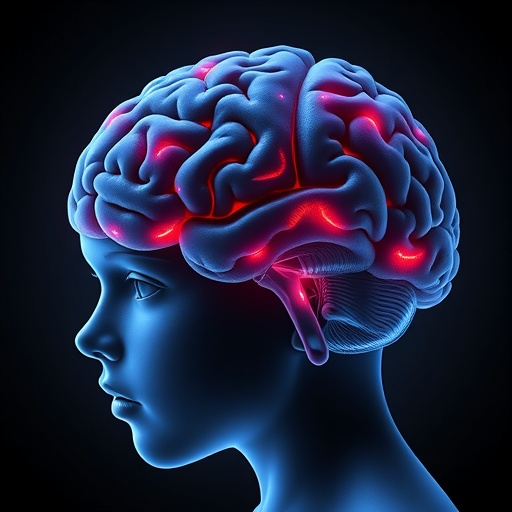Recent research highlights an unprecedented look at the connection between real-time aggression in youth and specific structural changes in their brains. Conducted by a team led by renowned neuroscientists, this study, published in the esteemed journal Discovery of Mental Health, provides compelling evidence regarding how certain brain regions correlate closely with behavioral tendencies related to aggression. These findings have profound implications for understanding the developmental mechanisms behind aggressive behavior in adolescents.
The research builds upon a growing body of literature that suggests aggression is not just a mere behavioral issue but is intricately linked to physiological alterations in the brain. Historically, the emphasis of studying aggression has been predominantly on environmental and social factors, but this new perspective suggests that neurological differences might also play a critical role. Through advanced neuroimaging techniques, the researchers aimed to discern how real-time aggressive actions are mirrored by structural variations in specific regions of the brain.
Central to this study is the investigation of various brain regions known to be involved in emotional regulation, impulse control, and social behavior. The amygdala, a key structure linked to emotional responses, was of particular interest to the research team. Their findings indicate that youths who exhibit more frequent aggressive behaviors also show marked changes in the volume and connectivity of the amygdala. Such alterations could signify a heightened emotional reactivity, making the individual more prone to aggressive outbursts.
Moreover, the study delves into the role of the prefrontal cortex, a region responsible for decision-making and impulse control. Interestingly, evidence suggests that structural abnormalities in the prefrontal cortex may weaken inhibitory control, leading to increased aggression. This aligns with earlier scientific perspectives where the balance of the limbic system and the prefrontal cortex is vital in moderating aggressive responses. The implications of this finding are significant, as they suggest that interventions aimed at enhancing the functioning of the prefrontal cortex may be beneficial in addressing aggressive tendencies in youth.
Additionally, this research explores the influence of environmental factors on structural brain changes. While genetic predispositions play a role in aggression, the study posits that environmental stimuli—such as exposure to violence, unstable living conditions, and negative parenting styles—can exacerbate structural changes in the brain. The researchers have underscored the importance of a holistic understanding of aggression, integrating both biological and environmental frameworks to provide more effective interventions.
Moreover, the use of real-time aggression measurements during the study allowed researchers to draw direct correlations between aggressive behavior and brain imaging results. This innovative approach provides a more dynamic view of aggression, shifting the narrative from static behavioral assessments to real-time behavioral evaluations. Such an advancement signifies a transformative leap in behavioral neuroscience, opening new avenues for research and targeted therapeutic strategies that could be employed in schools and clinical settings.
Another remarkable aspect of this study is its foundational approach in engaging the participants not merely as subjects, but as active contributors to the research process. By incorporating youth perspectives on feelings of aggression and emotional regulation, the researchers adorned the scientific analysis with rich qualitative data that enhances the quantitative findings.
In a broader context, the implications of this research may extend beyond the scientific community into policy-making and educational systems. By acknowledging the biological underpinnings of aggression, lawmakers and educational leaders may be better equipped to create supportive environments that address not only behavioral issues but also the underlying neural mechanisms that drive behavior.
In conclusion, this groundbreaking exploration into the interplay between real-time aggression and structural brain alterations in youth sets a new precedent in the field of mental health research. It underscores the necessity for a refined understanding of behavioral issues through the lens of neuroscience, which could lead to more precise and effective treatment modalities for aggression in young individuals. As further studies emerge, this research paves the way for interdisciplinary approaches, combining insights from psychology, neuroscience, and social sciences to unravel the complexities of human behavior.
Ultimately, the findings articulated in this study reflect both a challenge and an opportunity for society. Recognizing the neurological foundations of aggression inherently shifts the narrative from blame to understanding, fostering compassion and innovation in how we respond to aggressive behaviors in youth. This research not only changes the dialogue around juvenile aggression but could also be pivotal in reshaping mental health priorities worldwide.
Subject of Research: The connection between real-time aggression in youth and region-specific structural brain alterations.
Article Title: Real-time aggression in youth and its connection to region-specific structural brain alterations.
Article References:
Hatch, M., Dominguez, A., Bashford-Largo, J. et al. Real-time aggression in youth and its connection to region-specific structural brain alterations.
Discov Ment Health 5, 124 (2025). https://doi.org/10.1007/s44192-025-00273-8
Image Credits: AI Generated
DOI: 10.1007/s44192-025-00273-8
Keywords: Aggression, youth behavior, neuroscience, brain structure, emotional regulation, prefrontal cortex, amygdala.




